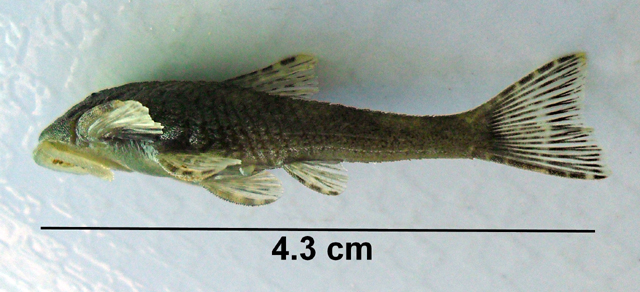| Loricariidae (Armored catfishes), subfamily: Hypoptopomatinae |
| 4.12 cm SL (male/unsexed) |
|
demersal; freshwater; depth range 0 - 1000 m |
| South America: Debaixo da Serra, a small stream in the upper reaches of the rio Grande basin (Alto Paraná), in Minas Gerais, Brazil. |
|
Distinguished from its only congener Pareiorhina rudolphi by the following characters: anterior profile of head elliptical in dorsal view; snout sloping abruptly towards its tip in lateral profile; ventral border of rostral region and dorsal border of upper lip covered with odontodes; anterior ends of premaxillae and dentaries strongly sloped inwards; lower lip moderately developed and well separated from anterior margin of pectoral girdle; lower lip with a smooth, unpapillose band just behind the toothed portions of dentaries, which is especially conspicuous just behind the symphysis; anterior regions of roof and floor of mouth immediately behind premaxillae and dentaries, respectively, covered with rounded papillae; interorbital width 36.6-39.4% HL; postdorsal surface of trunk with a low, elongate ridge formed by 10-13 raised median unpaired plates; posteriormost 2-3 median plates without sensory pores of lateral line; inferior surfaces of first pectoral, pelvic and anal-fin rays covered by conspicuously pointed odontodes; and lower counts of body plates (25-27 dorsal plates; 17-22 mid-dorsal plates; 25-27 median plates; 18-20 mid-ventral plates; and 19-23 ventral plates) (Ref. 52873). |
| Inhabits stream with clear, cold and moderate to fast flowing water (Ref. 52873). |
|
Least Concern (LC); Date assessed: 07 November 2018 Ref. (130435)
|
| harmless |
Source and more info: www.fishbase.org. For personal, classroom, and other internal use only. Not for publication.

